
Lungfish are freshwater vertebrates belonging to the class Dipnoi. Lungfish are best known for retaining ancestral characteristics within the Osteichthyes, including the ability to breathe air, and ancestral structures within Sarcopterygii, including the presence of lobed fins with a well-developed internal skeleton. Lungfish represent the closest living relatives of the tetrapods. The mouths of lungfish typically bear tooth plates, which are used to crush hard shelled organisms.

Vetulicola is a extinct genus of marine animal discovered from the Cambrian of China. It is the eponymous member of the enigmatic phylum Vetulicolia, which is of uncertain affinities but may belong to the deuterostomes. The name was derived from Vetulicola cuneata, the first species described by Hou Xian-guang in 1987 from the Lower Cambrian Chiungchussu Formation in Chengjiang, China.

Eotitanosuchus is an extinct genus of biarmosuchian therapsids whose fossils were found in the town of Ochyor in Perm Krai, Russia. It lived about 267 million years ago. The only species is Eotitanosuchus olsoni.

Doryaspis is an extinct genus of primitive jawless fish that lived in the Devonian period. Fossils have been discovered in Spitsbergen.

Drepanaspis is an extinct genus of primitive jawless Ostracoderms from the Early Devonian that belonged to the phylum Chordata, infraphylum Agnatha, class Pteraspidomorphi, and the subclass Heterostraci. Drepanaspis are assumed to have lived primarily in marine environments and is most commonly characterized by their ray-like, heavily armored bodies, along with their lack of paired fins and jaws.

Groenlandaspis is an extinct genus of arthrodire from the Late Devonian. Fossils of the different species are found in late Devonian strata in all continents except eastern Asia. The generic name commemorates the fact that the first specimens of the type species were found in Greenland.
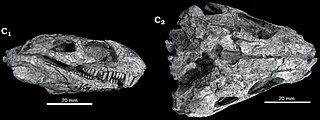
Eothyris is a genus of extinct synapsid in the family Eothyrididae from the early Permian. It was a carnivorous insectivorous animal, closely related to Oedaleops. Only the skull of Eothyris, first described in 1937, is known. It had a 6-centimetre-long (2.4-inch) skull, and its total estimated length was 30 centimetres. Eothyris is one of the most primitive synapsids known and is probably very similar to the common ancestor of all synapsids in many respects. The only known specimen of Eothyris was collected from the Artinskian-lower.
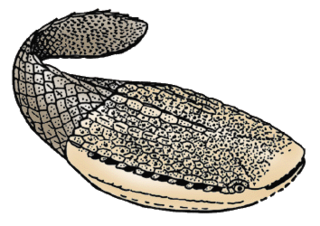
Astraspida, or astraspids, are a small group of extinct armored jawless vertebrates, which lived in the Middle Ordovician in North America. They are placed among the Pteraspidomorphi because of the large dorsal and ventral shield of their head armor. They are represented by a single genus, Astraspis, including possibly two species, A. desiderata and A. splendens but their remains are fairly abundant in Ordovician sandstones of the USA and Canada (Quebec). The head armor of Astraspis is rather massive, with a series of ten gill openings lining the margin of the dorsal shield, and laterally placed eyes. The dorsal shield is ribbed by strong longitudinal crests, and the tail is covered with large, diamond-shaped scales. They are often grouped together with the Arandaspidida.

Onychodus is a genus of prehistoric lobe-finned fish which lived during the Devonian period. It is one of the best known of the group of onychodontiform fishes. Scattered fossil bones of Onychodus were first discovered in 1857, in North America, and described by John Strong Newberry. Other species were found in Australia, England, Norway and Germany showing that it had a widespread range.

Phyllolepis is the type genus of Phyllolepida, an extinct taxon of arthrodire placoderm fish from the middle to late Devonian. The species of Phyllolepis, themselves, are restricted to the Famennian-aged freshwater strata of the Late Devonian, around 360 million years ago. Fossils of this genus have been found primarily in Europe and North America. The end of the Devonian saw them disappear in a mass extinction.

Chroniosuchus is an extinct genus of chroniosuchid from the upper Permian period. The genus was first named by Vjuschkov in 1957.
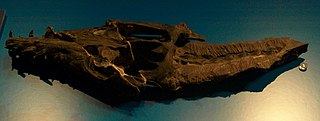
Augustasaurus is a genus of aquatic sauropterygian reptile belonging to the Pistosauria, a clade containing plesiosaurs and their close relatives. Pistosaurus and Augustasaurus were thought to be the only known members of the family Pistosauridae. However, some recent cladistic analyses found Augustasaurus to be a more advanced pistosaur, as a sister group of the order Plesiosauria. The only known species of Augustasaurus is Augustasaurus hagdorni, which was first described in 1997.

Holonema is an extinct genus of relatively large, barrel-shaped arthrodire placoderms that were found in oceans throughout the world from the Mid to Late Devonian, when the last species perished in the Frasnian-Fammian extinction event. Most species of the genus are known from fragments of their armor, but the Gogo Reef species, H. westolli, is known from whole, articulated specimens.
Coahomasuchus is an extinct genus of aetosaurine aetosaur. Remains of the genus have been found from deposits in Texas and North Carolina that date to the Otischalkian faunachron of the Late Triassic. It was small for an aetosaur, being less than 1.5 metres long. The dorsal plates are distinctively flat and unflexed, and have a faint sub-parallel to radial ornamentation. The genus lacked spines or keels on these plates, features seen in many other aetosaurs. Coahomasuchus was very similar in appearance to the closely related Aetosaurus.

Ptychoceratodus is an extinct genus of lungfish living from Early Triassic to Middle Jurassic. It was established by Otto Jaekel for one species, transferred from Ceratodus genus. Type species is P. serratus from the Middle Triassic of Switzerland and Germany. Ptychoceratodus had two pairs of massive dental plates, bearing 4-6 acute ridges. Its skull roof was composed from massive, plate-like bones. In the central part of skull roof was localized an unossified fenestra. Most of the Ptychoceratodus findings are isolated dental plates, some associated with jaws. Other parts of skull or postcranial skeleton are relatively rarely found as fossils. The anatomy of skull is the best recognized in P. serratus, whereas less complete cranial material is available also for P. concinuus, P. phillipsi, and P. rectangulus. Although Ptychoceratodus is known exclusively from the Triassic and Jurassic, there were also Cretaceous specimens referred to this genus. However, they are more often regarded as representants of Metaceratodus. Ptychoceratodus is the only member of the family Ptychoceratodontidae. The first named species is P. phillipsi by Louis Agassiz in 1837 as a species of Ceratodus and later moved to Ptychoceratodus genus. Occurrences of Ptychoceratodus come mainly from Europe. However, occurrences from other continents suggest it was dispersed globally during the Triassic. After 2010, the new fossil material behind the Europe was reported from South America, India, and Greenland

Fodonyx is an extinct genus of rhynchosaur from the middle Triassic epoch of Devon in England. Its fossils were discovered in Otter Sandstone Formation and were first assigned to Rhynchosaurus spenceri. This species was reassigned to its own genus, Fodonyx the holotype of which is EXEMS 60/1985/292, that described by David W. E. Hone and Michael J. Benton in 2008. More recently, one skull was reassigned to the new genus Bentonyx. It is distinguished from other rhynchosaurs by a single autapomorphy, the ventral angling of the paraoccipital processes. In all other rhynchosaurs these processes angle dorsally or are horizontal. It is not known if this conferred any advantage to Fodonyx. Fodonyx was between 40 and 50 cm long.
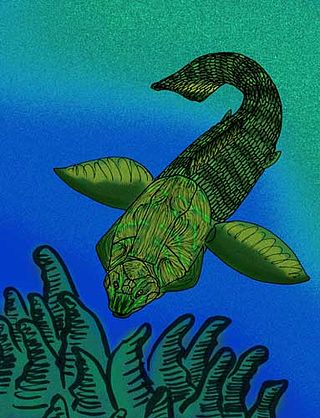
Holonematidae is an extinct family of relatively large arthrodire placoderms from the Early to Late Devonian. Almost all fossil specimens are of armor fragments, though, all have distinctive ornamentation, often of unique arrangements and patterns of tubercles, that are diagnostic of the family. The trunkshield is very elongated, giving the armor an overall "barrel" like appearance.
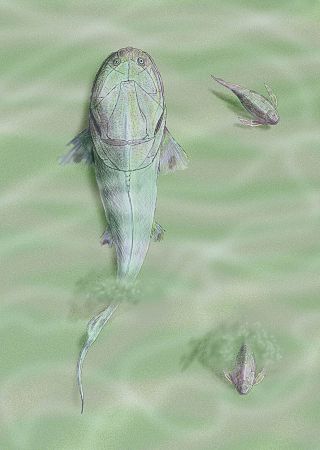
Homostiidae is a family of flattened arthrodire placoderms from the Early to Middle Devonian. Fossils appear in various strata in Europe, Russia, Morocco, Australia, Canada and Greenland.
Microbrachius is an extinct genus of tiny, advanced antiarch placoderms closely related to the bothriolepids. Specimens range in age from the Lower Devonian Late Emsian Stage to the Middle Devonian Upper Givetian Stage. They are characterized by having large heads with short thoracic armor of an average length of 2-4 cm. There are patterns of small, but noticeable tubercles on the armor, with the arrangement varying from species to species. Specimens of Microbrachius have been found in Scotland, Belarus, Estonia, and China.

Protopteraspididae is an extinct family of pteraspidid heterostracan agnathans. Fossils of the various genera are found in early Devonian-aged marine strata. Protopteraspidids were once thought to represent a taxon of basal pteraspidids but recent evaluations demonstrate that Protopteraspididae is a paraphyletic group of various transitional forms representing a gradual transition between the more advanced Pteraspoidei, and the anchipteraspidids and the Psammosteids.


















